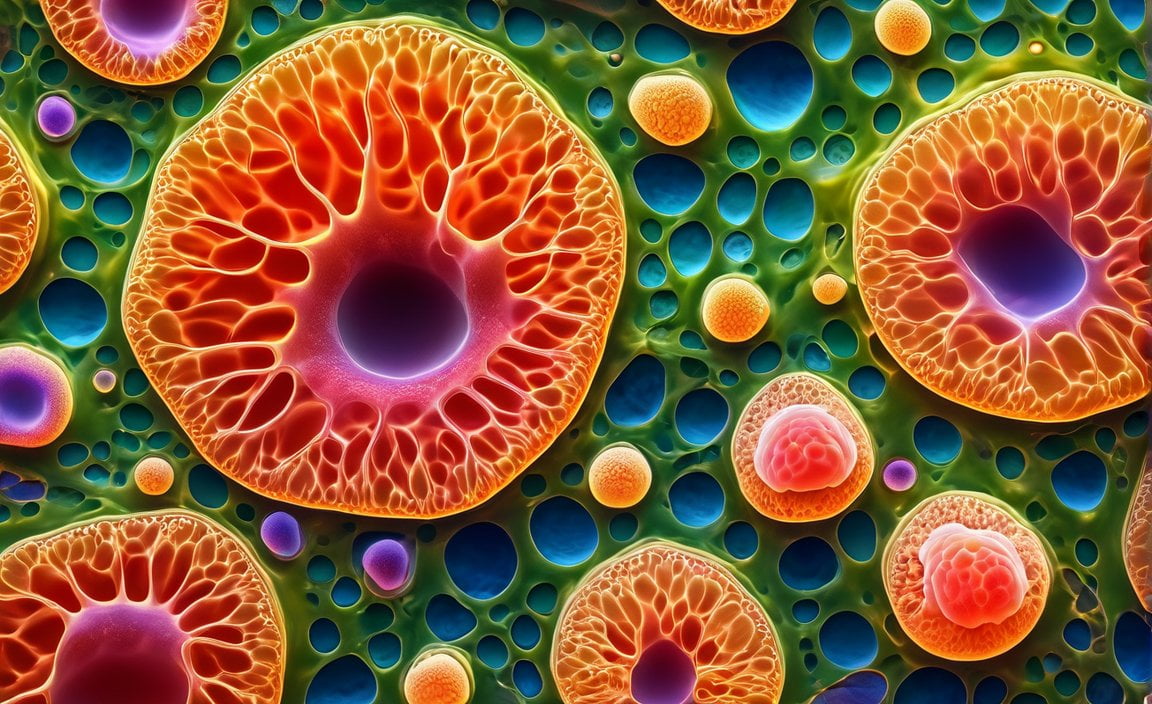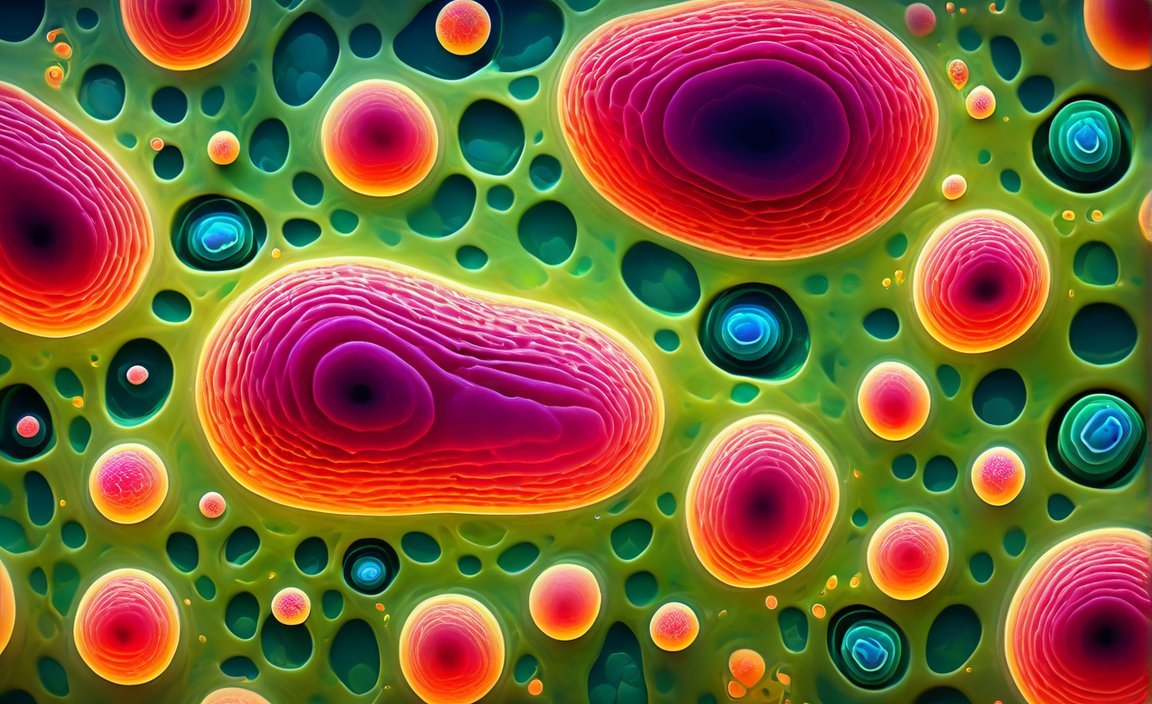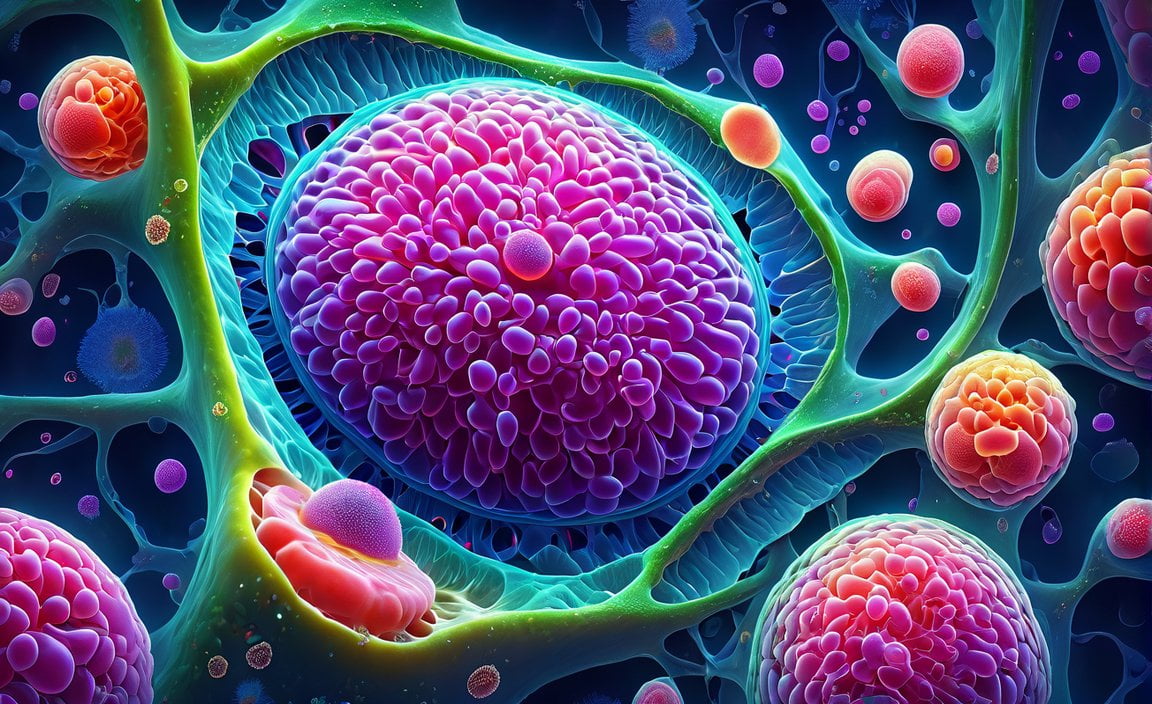Welcome to “Unveiling the Wonders: 10 Fascinating Facts About Plant and Animal Cells,” where we delve into the mesmerizing world of cellular biology. As we explore the intricate structures and functions of plant and animal cells, prepare to be amazed by the remarkable discoveries and intriguing facts that await. From uncovering the unique characteristics of these cells to unraveling the secrets behind their similarities and differences, we invite you to join us on this captivating journey of exploration and enlightenment.

Key Takeaways:
- Plant cells have a rectangular shape, while animal cells have an irregular shape.
- Plant cells have three unique features: chloroplasts, a cell wall, and a vacuole.
- Both animal and plant cells have mitochondria, but only plant cells have chloroplasts.
- Both plant and animal cells have vacuoles.
- Plant cells have a cell wall in addition to a cell membrane.
- Plant cells are generally larger than animal cells.
- Plants are autotrophs and produce energy through photosynthesis.
- Sources:
- Plant Cell Facts for Kids – Facts Just For Kids
- Plant vs animal cells review (article) – Khan Academy
10 Facts About Plant and Animal Cells
Plant and animal cells are the building blocks of life, as they contain all the necessary components to support the functions of living organisms. In this article, we will delve into the captivating world of cells and explore 10 intriguing facts about plant and animal cells that will leave you in awe.
1. The Shape Says It All
When we examine plant and animal cells under a microscope, one of the first things we notice is their distinct shapes. Plant cells have a rectangular or square shape, while animal cells have a more irregular and rounded shape. This variation in shape is due to the presence or absence of a cell wall and other unique structures.
2. The Green Powerhouse: Chloroplasts
One of the standout features of plant cells is the presence of chloroplasts. These remarkable organelles are responsible for capturing sunlight and converting it into energy through the process of photosynthesis. Animal cells, on the other hand, do not possess chloroplasts and rely on other mechanisms for energy production.
3. The Mighty Mitochondria
While both plant and animal cells contain mitochondria, the “powerhouses” of the cell, their functions may differ. Mitochondria play a crucial role in generating energy by breaking down food molecules and converting them into a form that cells can utilize. These energy factories are vital for the survival and functioning of both plant and animal cells.
4. Living Large
In terms of size, plant cells tend to be larger than animal cells. This difference can be attributed to the presence of a rigid cell wall in plant cells, which provides structural support and allows them to grow larger. Animal cells, lacking this protective wall, are typically smaller in size.
5. Multitalented Vacuoles
Vacuoles exist in both plant and animal cells, but their roles can vary. In plant cells, vacuoles serve as storage units, containing water, nutrients, and waste products. Additionally, they help maintain the cell’s shape and play a part in regulating water balance. Animal cells also have vacuoles, but they are typically smaller and fulfill a more specialized function.
6. The Protective Cell Wall
A significant feature unique to plant cells is the presence of a cell wall. This rigid structure surrounds the cell membrane and provides protection and support to the cell. It helps maintain the cell’s shape and prevents it from bursting under pressure. Animal cells do not possess a cell wall, making them more flexible in their movements.
7. Autotrophs vs. Heterotrophs
Plants are autotrophs, meaning they are capable of producing their own food through photosynthesis. With the help of chloroplasts, plants harness energy from sunlight to convert carbon dioxide and water into glucose, their primary source of energy. On the other hand, animals are heterotrophs, relying on consuming other organisms for their nutritional needs.
8. A Match Made in Heaven: Plant and Animal Cells
Although plant and animal cells have their unique features, they also share many similarities. Both types of cells contain various organelles, such as the nucleus, endoplasmic reticulum, Golgi apparatus, and cytoplasm, which are essential for their proper functioning. This common ground reflects the underlying unity of life.
9. Cells in Motion: Cilia and Flagella
In certain animal cells, hair-like structures called cilia and flagella enable cell movement. Cilia are short and numerous, while flagella are longer and fewer in number. These dynamic appendages play a vital role in cell locomotion, facilitating functions like the movement of sperm cells or assisting in the clearance of debris from respiratory passages.
10. Fascinating Diversity of Specialized Cells
Within the vast world of plant and animal cells, an immense variety of specialized cells exist. From nerve cells that transmit electrical impulses to xylem cells responsible for water transport in plants, each specialized cell carries out specific functions crucial to the overall functioning of tissues and organs.
In conclusion, exploring the wonders of plant and animal cells opens up a multitude of discoveries. Their unique structures and functions provide a framework for understanding the complexity and beauty of life itself. By unraveling the secrets held within these tiny units, we gain insights into the incredible mechanisms that sustain all living organisms on Earth.
Did you know that marine environments are home to a wide variety of fascinating creatures? Dive into the depths of the ocean and discover 10 intriguing facts about marine environment. 10 facts about marine environment
Learn about the mesmerizing world of ocean creatures and uncover 10 mind-blowing facts that will leave you in awe. Explore the wonders of the sea and its inhabitants. 10 facts about ocean creatures
Delve into the enchanting realm of sea life and uncover 10 astonishing facts that will amaze you. Discover the beauty and diversity of creatures that inhabit the ocean. 10 facts about sea life
Embark on a wild adventure as you explore the animal kingdom and its many inhabitants. Uncover 10 intriguing facts about wild animals and gain a deeper understanding of their fascinating lives. 10 facts about wild animals
Both Plant and Animal Cells: The Genetic Material Storage
The nucleus is a vital component of both plant and animal cells, playing a crucial role in storing genetic material. Let’s uncover 10 fascinating facts about plant and animal cells that highlight the significance of this shared characteristic.
1. The Nucleus: A Genetic Treasure Trove
The nucleus stands as the command center of the cell, housing the genetic instructions that determine an organism’s traits and characteristics. It contains DNA, in the form of chromosomes, which store the blueprint for a cell’s activities. [Both plant and animal cells have a nucleus that stores the genetic material.]
2. The Eukaryotic Marvel
Both plant and animal cells are eukaryotic, meaning their genetic material is enclosed within a defined nucleus. This distinction sets them apart from prokaryotic cells, such as bacteria, which lack this compartmentalization. Thus, plant and animal cells share the foundational feature of having a nucleus.
3. Membrane-Bound Organelles
In addition to the nucleus, plant and animal cells possess other membrane-bound organelles, such as mitochondria, Golgi complex, endoplasmic reticulum, and ribosomes. These structures perform specialized functions critical for the cell’s survival and overall performance.
4. Cell Wall: A Vegetal Stronghold
While animal cells lack a cell wall, plant cells boast an additional layer of protection. Composed primarily of cellulose, the plant cell’s rigid cell wall offers support and structural integrity. This unique feature provides plants with their characteristic shape, especially the rectangular or square shape often associated with plant cells.
5. Chloroplasts: Plant Cell Powerhouses
Plant cells possess chloroplasts, which are responsible for the process of photosynthesis. These remarkable organelles convert light energy into chemical energy, enabling plants to produce glucose and oxygen. In contrast, animal cells lack chloroplasts and must acquire energy through other means, such as consuming food.
6. Vacuoles: Size Matters
Vacuoles, structures that store water, nutrients, and waste, are present in both plant and animal cells. However, there is a notable distinction in their size and distribution. Animal cells tend to have multiple small vacuoles, while plant cells feature a large central vacuole occupying a significant portion of the cell’s volume. This central vacuole serves various functions, including maintaining turgor pressure and storing necessary compounds.
7. Lysosomes: Animal Cell Cleaning Crew
Lysosomes, which house enzymes responsible for breaking down waste materials and cellular debris, are present in animal cells but absent in plant cells. These cellular “cleaning crews” aid in the recycling of molecules and the maintenance of a healthy cellular environment.
8. Diverse Shapes and Sizes
Plant and animal cells showcase a diversity of shapes and sizes, reflecting their distinct functions and structures. While plant cells feature a more uniform shape due to the presence of a cell wall, animal cells exhibit a greater variety of shapes, ranging from irregular to rounded. These unique characteristics allow cells to fulfill their specialized roles efficiently.
9. Structures for Cellular Movement
Some animal cells possess cilia and flagella, slender structures extending from the cell membrane, facilitating cell movement. These hair-like projections help propel cells through their environment. In contrast, plant cells do not require such motility mechanisms, as their immobility is offset by other adaptations, such as those associated with reproduction and seed dispersal.
10. Specialized Cell Diversity
Both plant and animal cells exhibit a breathtaking array of specialized cells designed to perform specific functions. From neurons transmitting electrical signals to xylem cells facilitating water transport in plants, these specialized cells allow organisms to carry out complex processes essential for their survival and growth.
Key Takeaways:
– Plant and animal cells feature a nucleus that stores genetic material, highlighting their shared eukaryotic nature.
– Plant cells have a distinct cell wall made of cellulose, which animal cells lack.
– Chloroplasts are exclusive to plant cells, enabling them to partake in photosynthesis.
– Animal cells may contain lysosomes, responsible for breaking down waste materials, while plant cells do not.
– Plant cells possess a large central vacuole, while animal cells may have multiple smaller vacuoles.
– Despite differing shapes, both plant and animal cells share essential organelles like mitochondria, Golgi complex, endoplasmic reticulum, and ribosomes.
– Some animal cells utilize cilia and flagella for cell movement, a feature absent in plant cells.
– The diversity of specialized cells in both plant and animal organisms is astonishing, allowing them to carry out complex functions efficiently.
Citation:
Khan Academy: Plant vs animal cells review (article)
ThoughtCo: Differences Between Plant and Animal Cells
Unveiling the Wonders: 10 Fascinating Facts About Plant and Animal Cells
Plant cells have chloroplasts, which enable them to carry out photosynthesis. This remarkable process allows plants to convert light energy into chemical energy, resulting in the production of oxygen and energy-rich organic compounds. Let’s dive into the fascinating world of plant and animal cells and explore ten compelling facts that showcase their unique characteristics, similarities, and differences.
1. The Marvel of Chloroplasts: Powerhouses of Photosynthesis
The first fact that captivates our attention is the presence of chloroplasts in plant cells. These specialized organelles are responsible for capturing the energy of sunlight and carrying out the process of photosynthesis. Within the chloroplasts, light energy is converted into chemical energy, which plants utilize to synthesize glucose and other essential organic compounds. This photosynthetic powerhouse differentiates plant cells from animal cells, as the latter lack chloroplasts.
2. Evolutionary Echoes: Origins of Chloroplasts
To truly comprehend the significance of chloroplasts, we must explore their intriguing origins. Chloroplasts are believed to have emerged from endosymbiotic cyanobacteria. Through a process called endosymbiosis, ancient cyanobacteria entered the cells of early plant ancestors, establishing a mutually beneficial relationship. Over time, this integration led to the evolution of the chloroplast, equipping plants with the miraculous ability to harness the energy of the sun.
3. Dive into the Membrane Maze: The Chloroplast Envelope
Within plant cells, chloroplasts are protected by a double membrane known as the chloroplast envelope. This protective barrier separates the chloroplast from the cell’s cytoplasm, regulating the movement of molecules in and out of the organelle. The chloroplast envelope plays a crucial role in maintaining the integrity and functionality of chloroplasts.
4. Beyond Chloroplasts: Plant Cell Structures
While chloroplasts are the hallmark of plant cells, these cells possess other remarkable features that contribute to their functions. Plant cells have cell walls that provide rigidity and support, giving plants their characteristic shape. Additionally, plant cells contain vacuoles, which allow them to change their size and store vital substances, such as water, nutrients, and waste products.
5. The Dance of Photosynthesis: A Symphony of Light and Energy
Photosynthesis, the process facilitated by chloroplasts, is a captivating ballet between light energy, carbon dioxide, and water. Through this intricate dance, cells utilize carbon dioxide and energy obtained from sunlight to produce glucose, a molecule crucial for plant growth and survival. As a byproduct of photosynthesis, oxygen is released into the atmosphere, enriching our environment.
6. Efficiency at its Finest: Efficient Adaptations of Chloroplasts
Chloroplasts in plant cells have evolved numerous adaptations that enhance the efficiency of photosynthesis. Thylakoids, flattened sac-like structures within the chloroplasts, provide a large surface area for light absorption and house the photosynthetic pigments responsible for capturing light energy. Chloroplasts also contain grana, stacks of thylakoids that optimize the capture and utilization of light energy.
7. Embracing Diversity: Plastids in Plant Cells
In addition to chloroplasts, plant cells also harbor other types of plastids, such as chromoplasts and leucoplasts. Chromoplasts are responsible for synthesizing and storing pigments, contributing to the vibrant colors seen in fruits and flowers. Leucoplasts, on the other hand, are involved in the synthesis and storage of starch and other essential substances.
8. Comparing the Uncomparable: Plant vs. Animal Cells
Plant cells exhibit distinctive features that set them apart from animal cells. In addition to possessing chloroplasts for photosynthesis, plant cells have a cell wall composed of cellulose, providing structural support and protection. Animal cells lack cell walls, allowing for more flexibility in shape and movement. These differences highlight the diverse adaptations that organisms have developed to thrive in their respective environments.
9. The Command Center: Nucleus in Plant and Animal Cells
Both plant and animal cells contain a nucleus, which acts as the command center. The nucleus stores the genetic material, including DNA, and regulates the cell’s activities. This vital organelle is essential for cell growth, division, and the inheritance of genetic traits. The presence of a defined nucleus is a defining characteristic that distinguishes eukaryotic cells, such as plant and animal cells, from prokaryotic cells.
10. Key Takeaways:
- Plant cells have chloroplasts that enable them to carry out photosynthesis, capturing light energy and converting it into chemical energy.
- Chloroplasts are believed to have originated from endosymbiotic cyanobacteria, illustrating the fascinating evolutionary history of plant cells.
- Within plant cells, the chloroplast envelope forms a double membrane, protecting and regulating the exchange of molecules within the chloroplasts.
- In addition to chloroplasts, plant cells possess unique structures such as cell walls and vacuoles, contributing to their rigidity, support, and ability to change size.
- Photosynthesis, facilitated by chloroplasts, is a remarkable process through which cells utilize light energy, carbon dioxide, and water to produce glucose and release oxygen.
- Efficient chloroplast adaptations, including thylakoids and grana, optimize the capture and utilization of light energy during photosynthesis.
- Plant cells harbor various types of plastids, including chromoplasts and leucoplasts, with distinct functions related to pigment synthesis, storage, and substance synthesis.
- Plant cells possess a cell wall made of cellulose, differentiating them from animal cells and providing structural support and protection.
- Both plant and animal cells contain a nucleus, serving as the command center and storing genetic material essential for cell functions.
- Plant and animal cells exhibit unique characteristics, reflecting their adaptations to different environments, yet share fundamental features as eukaryotic cells.
Sources:
1. Nature – Plant Cells, Chloroplasts, Cell Walls
2. Britannica – Chloroplast
Animal Cells: Unveiling the Wonders of Centrioles
Animal cells, the building blocks of complex organisms, harbor a plethora of mysteries waiting to be unraveled. One fascinating aspect is the presence of specialized structures called centrioles that play a crucial role in the process of cell division. Let’s dive deeper into the captivating world of animal cells and explore the ten compelling facts that highlight the significance of centrioles in their biology.
Key Takeaways:
- Centrioles are small, hollow cylinders found in animal cells that aid in cell division.
- They are typically arranged in pairs, with one mother centriole and one daughter centriole, positioned at right angles to each other.
- Composed of microtubules, centrioles organize the microtubule network within the cell.
- Centrioles contribute to the formation of spindle fibers, critical for separating chromosomes during cell division.
- These specialized structures are exclusively found in animal cells and some lower plant cells like Chlamydomonas.
- Centrioles are absent in fungi, angiosperms (flowering plants), and pinophyta (conifers).
- The centrosome, a complex associated with microtubule organizing centers (MTOCs), consists of two centrioles.
- Centrioles play a pivotal role in nuclear positioning and the cell cycle.
- While animal cells possess centrosomes containing centrioles, plant cells have a different mechanism for mitosis without centrioles.
- The link between centrioles and the overall structure and function of the cell remains an active area of research.
Now, let’s embark on a journey through ten captivating facts that shed light on the remarkable world of animal cells and the pivotal role of centrioles in their biology.
Fact 1: Centrioles – Tiny Cylinders Powering Cell Division
Animal cells possess a unique structure known as the centriole, a small, hollow cylinder that aids in cell division. Centrioles are vital for the accurate separation of chromosomes during the process of cell division.
Fact 2: A Pair of Centrioles: Mother and Daughter
Centrioles are typically found in pairs within animal cells. This pair consists of a mother centriole and a daughter centriole. They are positioned at right angles to each other, providing stability and facilitating the organization of cellular structures.
Fact 3: Microtubule Architects
Composed of microtubules, centrioles play a crucial role in organizing the microtubule network present in the cell. Microtubules are dynamic structures that form essential components of the cellular cytoskeleton.
Fact 4: Spindle Fiber Formation for Chromosome Separation
Centrioles contribute significantly to the formation of spindle fibers. These fibers are responsible for the faithful separation of chromosomes during cell division, ensuring that each new cell receives the accurate genetic material.
Fact 5: Exclusive to Animal Cells and some Lower Plants
Centrioles are remarkable structures found solely in animal cells and some lower plant cells like Chlamydomonas. They are absent in fungi, angiosperms (flowering plants), and pinophyta (conifers), illustrating their unique role in animal cell biology.
Fact 6: The Centrosome – The Command Center
The centrosome, a crucial component of animal cells, plays a pivotal role in microtubule organizing centers (MTOCs). It consists of a pair of centrioles and serves as the command center for cellular organization during cell division.
Fact 7: Steering the Nucleus and Cell Cycle
Centrioles, with their strategic positioning, actively participate in the proper positioning of the nucleus within the cell. Additionally, they are intricately involved in orchestrating the cell cycle, ensuring the precise division and distribution of genetic material.
Fact 8: Animal Cells vs. Plant Cells – Mitotic Mechanisms
While animal cells possess centrosomes containing centrioles, plant cells have a distinct mechanism for cell division without centrioles. Plant cells adopt alternative strategies to ensure accurate chromosome separation during mitosis.
Fact 9: A Constant Source of Research and Study
The relationship between centrioles and the overall structure and function of the cell remains an active area of research. Scientists continuously seek to unveil the mysteries surrounding centrioles, deepening our understanding of their significance in the complex world of cell biology.
Fact 10: All Cells are Special
Beyond the role of centrioles in cell division, it is worth noting that specialized animal cells, such as red blood cells, sperm, and eggs, harbor additional components that enable them to fulfill their unique purposes within the organism. The remarkable adaptations of these cells provide further evidence of the intricacies of animal cell biology.
So there you have it, ten captivating facts about animal cells and their remarkable centrioles. These tiny, cylindrical structures are crucial for the precise division of genetic material and the proper functioning of cells in the animal kingdom. As science continues to unfold the mysteries of these miniature wonders, we gain a deeper appreciation for the intricate mechanisms that sustain life.
Sources:
– Sciencing – Centriole: Definition, Function & Structure
– British Society for Cell Biology – Centriole

FAQ
Q1: What are some differences between plant and animal cells?
A1: Plant cells have a rectangular shape, while animal cells have an irregular shape. Additionally, plant cells have three unique features that animal cells do not: chloroplasts, a cell wall, and a vacuole.
Q2: Do both plant and animal cells have mitochondria?
A2: Yes, both plant and animal cells have mitochondria. However, only plant cells have chloroplasts, which are responsible for photosynthesis.
Q3: What is the main difference in vacuole structure between plant and animal cells?
A3: While both plant and animal cells have vacuoles, plant cells typically have a large central vacuole, while animal cells may have multiple small vacuoles.
Q4: How do plant cells obtain energy?
A4: Plant cells are autotrophs, meaning they can produce energy from sunlight through the process of photosynthesis. They have chloroplasts that capture the energy of the sun and convert it into energy-rich molecules.
Q5: What is the role of centrioles in animal cells?
A5: Centrioles are small, hollow cylinders found in animal cells that play a crucial role in cell division. They help in the formation of spindle fibers that separate chromosomes during cell division. Plant cells do not have centrioles.
















